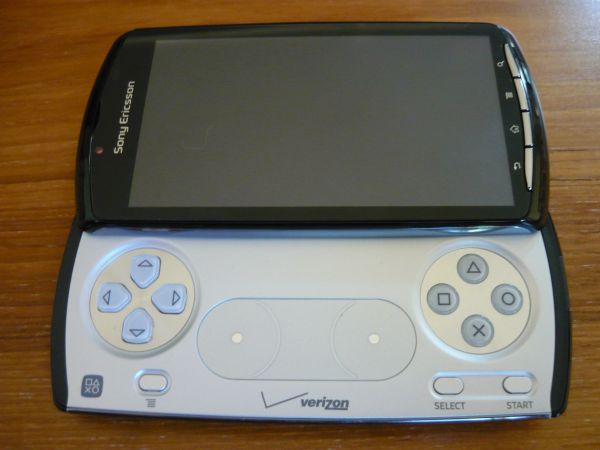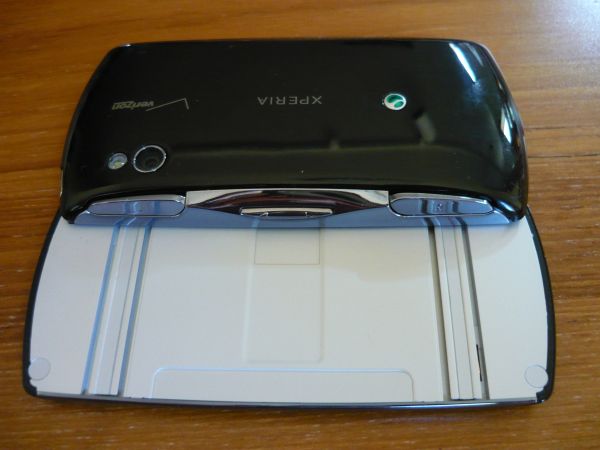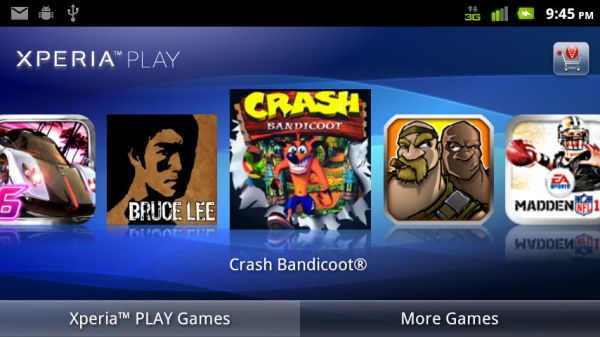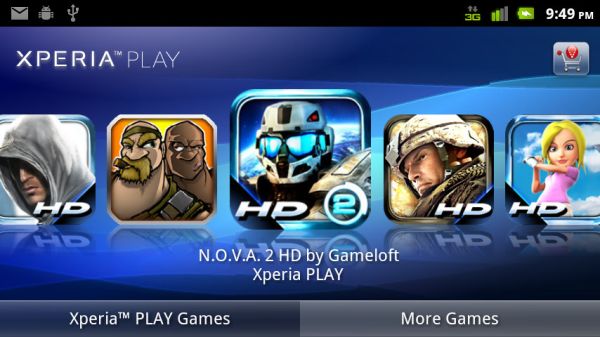The Sony Ericsson Xperia Play: Where Do You Want To Take Your Gaming Today?
by Brian Dipert on August 8, 2011 1:26 PM EST- Posted in
- Smartphones
- Sony
- Android
- Xperia Play
- Mobile
Gaming is at the core of the Xperia Play's "raison d'être," of course, so it deserves some focused editorial attention. Slide the screen up and underneath it you'll find the gamepad, which is conceptually reminiscent of a DualShock controller. You already saw this photo a few pages back; here it is again as a reminder:
On one end is a digital directional key suite, and on the other is a set of 'face' buttons. Below them are an Android 'start' button (on the left) and 'select' and 'start' buttons (on the right). Since Sony Ericsson desired to make the Xperia Play as thin as possible, there's no vertical room for DualShock-like D-Pad analog sticks or even the single, thinner analog joystick of a PlayStation Portable. Instead, Sony Ericsson substituted circular capacitive sliders, with capacitive buttons (providing, among other things, orientation-handy indents) in their centers. And where are the DualShock-like L1 and R1 controls? In normal portrait-orientation phone use, they're on one side of the Xperia Play, bracketing the volume toggle. And when you're ready to "get your game on" and landscape orientation-rotate the phone, they end up on the top edges of the lower slider layer, behind the screen.
Verizon bundles seven game titles with its version of the the Xperia Play: Asphalt 6, Bruce Lee: Dragon Warrior, Crash Bandicoot, Madden NFL 2011, Tetris, The Sims 3, and Star Battalion, accessible both standalone via the Android home screen and (with the exception of Tetris, for unknown reasons) within the Xperia Play application:
Additional content is available for download through the Xperia Play app, on a separate screen. I counted 43 titles, at a range of first-download (up to $9.99, from my limited sampling) and subscription (up to $3.49) prices. But what currently exists isn't hardware-exclusive; it's also available on other platforms:
To that point, one common complaint I read from Xperia Play owners is that they needed to re-purchase game titles they'd already bought for other Sony hardware; the existing licenses couldn't be expanded (or at least transferred) to include the Xperia Play. Folks also weren't particularly fond of the D-Pad-replacing capacitive circular pads, and I tend to concur; my success in convincing them to react in the way I intended was somewhat hit-and-miss, and the overall lack of tactile feedback versus a joystick left me overwhelmed. With that said, I'm more forgiving than some in understanding the design constraints that compelled Sony Ericsson to use them.
The bundled, Xperia Play-optimized games I auditioned generally provided an acceptable playback experience, albeit with occasional stutters on a few titles. Bruce Lee: Dragon Warrior was probably the most immersive title I tried, from both audio and visual standpoints; I say this as someone who's not even a particular fan of the action fighter genre. Flight simulation and racing games are more my cup of tea; as such, Asphalt 6 and Star Battalion didn't disappoint, either, though I generally found myself underwhelmed by the inferior richness of the Xperia Play titles (which were reminiscent to me of PlayStation 1 or Nintendo 64 content of days past) in comparison to games intended for a dedicated-function portable console.
As you'll read in detail in the sections to come, the Xperia Play's hardware allotment is modest, but leading-edge graphics drivers from Qualcomm provide the phone with more robust performance than that of its similar-component peers. Nonetheless, the dearth of compelling Xperia Play-optimized content is disappointing, and dulls the overall enthusiasm for the system. Hopefully, AT&T's recent embrace of the Xperia Play is indicative of better news to (soon) come in this regard. And speaking of hardware, a mini-HDMI output that would enable optional tethering of the Xperia Play to a television or other larger display for a more immersive gaming experience is also a notable 'miss'; perhaps if a second-generation design ever appears, Sony Ericsson will see fit to include such a capability.
Other games can be downloaded from Google's Android Market, the Amazon Market for Android, or the Verizon VCast Store. I frankly don't recommend the VCast Store, due both due to its comparatively limited selection and higher prices. Gun Bros, for example, is available for free from the Android Market; the very same title will cost you $6.99 for first download from the VCast Store, or $2.99 for re-download. These generic Android titles don't leverage the Xperia Play gamepad, of course, no matter that they play smoothly on the hardware. Fortunately, many of them harness the handset's accelerometer, as do (optionally, versus the mechanical controls) the Xperia Play-optimized titles.














34 Comments
View All Comments
SilthDraeth - Monday, August 8, 2011 - link
I wonder why they chose a Dpad for directional control vs a flat analog slider pad reminiscent of the Nintendo 3ds?I would have thought the analog slider pad would have better mimicked the capacitive touch circle control. In fact I probably would play some more N.O.V.A 2 if my Samsung epic had a analog slider pad.
I wonder, if maybe they didn't do it, because at the time the phone was designed and released, the 3DS hadn't came out, and no one had thought of it yet...
LordOfTheBoired - Tuesday, August 9, 2011 - link
Interesting theory, but there's a problem with it... the PSP had a flat analog slider long before the 3DS did.It's also an input that is largely reviled by the fans, and not without justification.
Though the fans think the problem is that it isn't a "real stick"(actually, two of them) rising high above the face of the device like a home gamepad(specifically, like the DualShock series of gamepads), and to hell with pocketability. See also: the upcoming PS Vita.
Personally, I think it was just a poorly-considered implementation of a good device.
The fault as I see it is that it's topped with a convex thumb-piece and the centering springs are fairly high-tension. Though the awkward location doesn't help matters either(I'm pretty sure the slider was shoehorned in late in the system's development and it was intended to be digital-only).
I'm rather disappointed to know the capacitive disks don't work, as I thought they were a good idea. Especially as it avoided the preference for cardinal directions in dual-spring potentiometer designs(a very strong preference in the case of the PSP's high-tension slider).
Guspaz - Tuesday, August 9, 2011 - link
Good idea, terrible implementation. While I'm not a PSP owner,and have only played with them a bit, my experience was that the problems were:1) Horribly positioned. My hand cramped up using the analog nub on the PSP while simultaneously holding the PSP with that hand
2) Concave form factor made it harder to grip
3) Rough texture was uncomfortable
4) Spring put up too much resistance
5) Too small and not enough range of motion
The 3DS circle pad attempts to address all of these complaints, and while it isn't quite perfect, it's a good enough implementation that it can compete with "real" analog sticks rather nicely. Of course, by giving it good positioning, it makes the 3DS' d-pad uncomfortable to use, but you can't have it both ways. Anyhow, a circle-pad would certainly fit on something like the xperia play. In fact, I wish that the circle-pad was on more devices, but unfortunately Nintendo's patents will prevent that. Hopefully Sony can come up with their own similar slider pad that, if not identical to the circle pad, at least makes the same corrections.
MacTheSpoon - Monday, August 8, 2011 - link
This first gen phone is underwhelming, but I hope they stick with the concept and iron out the problems. The underlying concept of a smartphone with physical game controls seems spot-on. I'd love to play console-type games on my phone using physical controls instead of multitouch.ImSpartacus - Monday, August 8, 2011 - link
The first gen phone is underwhelming and ever single phone after that will follow similarly.Why? The Vita. I can't understand why Sony thought it was a good idea to split the Vita and Xperia Play. If you want to compete with iOS gaming, you can't do it with two distinct devices. Sony needs a unified gaming device. They are welcome to sell a wifi version (a la iPod Touch), but their flagship needs to be a phone.
seamonkey79 - Monday, August 8, 2011 - link
^ ThisExodite - Monday, August 8, 2011 - link
Because Sony isn't the same company as Sony Ericsson?It's not even a subsidiary, indeed SE is made up from far more of the old Ericsson phone division than it is Sony.
This isn't in any way, shape of form a 'Sony' phone - Sony doesn't do phones.
ImSpartacus - Monday, August 8, 2011 - link
Then Sony should do phones.Zoomer - Tuesday, August 9, 2011 - link
Not outside Japan, anyway.Guspaz - Tuesday, August 9, 2011 - link
Sony Ericsson is 50% owned by Sony and 50% owned by Ericsson. They make Walkman-branded phones, Cyber-shot branded phones, BRAVIA-branded phones... Sony and Ericsson could clearly have come to an agreement if Sony had wanted to do this all in one device.After all, the XPeria Play and Vita are similar architecturally. They both use ARM SoCs (a departure for Sony in a game console), although the XPeria Play is using a Qualcomm Snapdragon with an Adreno GPU while the Vita is using a quad-core ARM Cortex A9 with a PowerVR SGX534MP4.
In actual fact, the hardware in the Vita is identical to the iPad 2 except doubled (same CPU/GPU, just double the cores each).